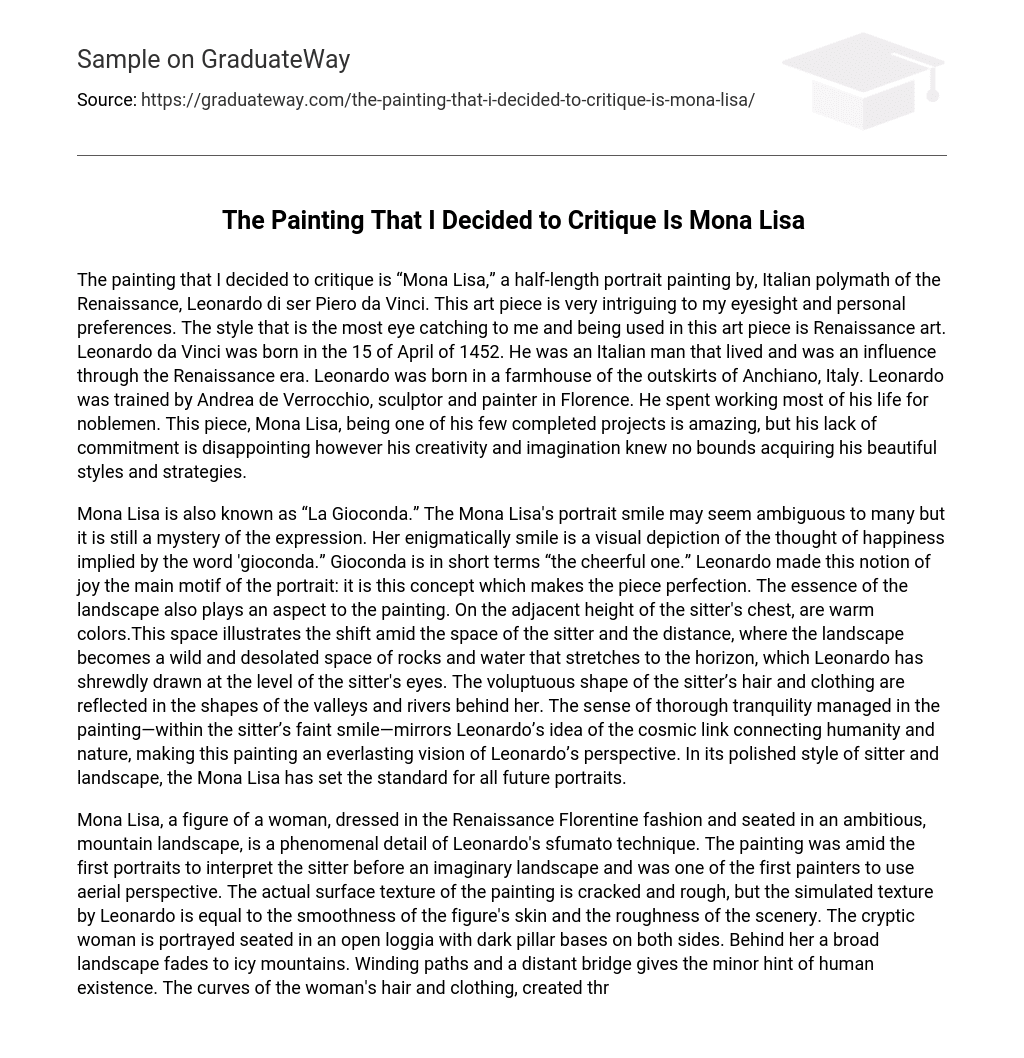The painting that I decided to critique is “Mona Lisa,” a half-length portrait painting by, Italian polymath of the Renaissance, Leonardo di ser Piero da Vinci. This art piece is very intriguing to my eyesight and personal preferences. The style that is the most eye catching to me and being used in this art piece is Renaissance art. Leonardo da Vinci was born in the 15 of April of 1452. He was an Italian man that lived and was an influence through the Renaissance era. Leonardo was born in a farmhouse of the outskirts of Anchiano, Italy. Leonardo was trained by Andrea de Verrocchio, sculptor and painter in Florence. He spent working most of his life for noblemen. This piece, Mona Lisa, being one of his few completed projects is amazing, but his lack of commitment is disappointing however his creativity and imagination knew no bounds acquiring his beautiful styles and strategies.
Mona Lisa is also known as “La Gioconda.” The Mona Lisa’s portrait smile may seem ambiguous to many but it is still a mystery of the expression. Her enigmatically smile is a visual depiction of the thought of happiness implied by the word ‘gioconda.” Gioconda is in short terms “the cheerful one.” Leonardo made this notion of joy the main motif of the portrait: it is this concept which makes the piece perfection. The essence of the landscape also plays an aspect to the painting. On the adjacent height of the sitter’s chest, are warm colors.This space illustrates the shift amid the space of the sitter and the distance, where the landscape becomes a wild and desolated space of rocks and water that stretches to the horizon, which Leonardo has shrewdly drawn at the level of the sitter’s eyes. The voluptuous shape of the sitter’s hair and clothing are reflected in the shapes of the valleys and rivers behind her. The sense of thorough tranquility managed in the painting—within the sitter’s faint smile—mirrors Leonardo’s idea of the cosmic link connecting humanity and nature, making this painting an everlasting vision of Leonardo’s perspective. In its polished style of sitter and landscape, the Mona Lisa has set the standard for all future portraits.
Mona Lisa, a figure of a woman, dressed in the Renaissance Florentine fashion and seated in an ambitious, mountain landscape, is a phenomenal detail of Leonardo’s sfumato technique. The painting was amid the first portraits to interpret the sitter before an imaginary landscape and was one of the first painters to use aerial perspective. The actual surface texture of the painting is cracked and rough, but the simulated texture by Leonardo is equal to the smoothness of the figure’s skin and the roughness of the scenery. The cryptic woman is portrayed seated in an open loggia with dark pillar bases on both sides. Behind her a broad landscape fades to icy mountains. Winding paths and a distant bridge gives the minor hint of human existence. The curves of the woman’s hair and clothing, created through sfumato, are reflected in the slender imaginary valleys and rivers behind her. The colors used in the Mona Lisa are earthy tones to express a vague feeling and warm colors to make her stand out. Leonardo was absorbed by the way light reflected gracefully on curved surfaces. The diaphanous veil, Mona Lisa’s hair, the glow of her skin – all are created with thin layers of color, each layer very slim and delicate, making the lady’s face appear to beam, and giving the painting an exquisite, almost magical aspect. The blurred outlines, smooth figure, sharp contrasts of light and dark, and overall the feeling of harmony are attributes of da Vinci’s style.
In conclusion this piece is an enjoyable painting that is seen by Da Vinci, it makes me feel very joyful by the genuine smile and expression of Mona Lisa. The background creates a feeling of serenity within oneself and that it’s a way anyone should feel in peace. The painting of Mona Lisa is personally a spectacular creation of nature and also represents the species: the portrait goes farther its social obstructions and obtains a universal essence. The style of the painting is well mastered and visually pleasant to the eye. Containing a rough real feeling and a smooth visual texture. This painting had a crucial impact over Florentine portraits for the next 20 years, over the classical portrait. With Mona Lisa, Leonardo painted and created an oeuvre, more impressive, vigorous, detailed, and yet more poetic than his predecessors. Before him, portraits lacked enigma; artists only exhibited exterior facades without any soul, or, if they did, they tried to reveal it through gestures, emblematic objects or inscriptions. The Mona Lisa alone is a living enigma: the soul is there, but unattainable.





